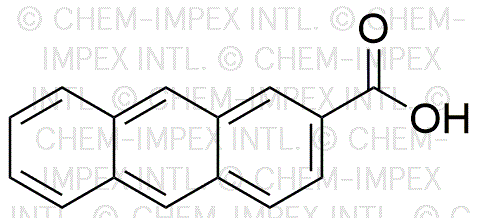2-Anthracenecarboxylic acid is widely utilized in research focused on:
- Organic Synthesis: This compound serves as a key building block in the synthesis of various organic materials, including dyes and pharmaceuticals, due to its stable structure and reactivity.
- Fluorescent Probes: Its unique fluorescence properties make it an excellent candidate for developing fluorescent probes used in biological imaging and detection methods.
- Polymer Chemistry: It can be incorporated into polymers to enhance their optical properties, making it valuable in the production of advanced materials for electronics and coatings.
- Research in Material Science: The compound is studied for its potential in creating new materials with specific electronic and optical characteristics, which can lead to innovations in sensors and solar cells.
- Pharmaceutical Applications: Its derivatives are explored for potential therapeutic uses, particularly in cancer research, due to their ability to interact with biological systems effectively.
Informations générales
Propriétés
Sécurité et réglementation
Applications
2-Anthracenecarboxylic acid is widely utilized in research focused on:
- Organic Synthesis: This compound serves as a key building block in the synthesis of various organic materials, including dyes and pharmaceuticals, due to its stable structure and reactivity.
- Fluorescent Probes: Its unique fluorescence properties make it an excellent candidate for developing fluorescent probes used in biological imaging and detection methods.
- Polymer Chemistry: It can be incorporated into polymers to enhance their optical properties, making it valuable in the production of advanced materials for electronics and coatings.
- Research in Material Science: The compound is studied for its potential in creating new materials with specific electronic and optical characteristics, which can lead to innovations in sensors and solar cells.
- Pharmaceutical Applications: Its derivatives are explored for potential therapeutic uses, particularly in cancer research, due to their ability to interact with biological systems effectively.
Documents
Fiches de données de sécurité (FDS)
La FDS fournit des informations de sécurité complètes sur la manipulation, le stockage et l’élimination du produit.
Spécifications du produit (PS)
Le PS fournit une description complète des propriétés du produit, notamment sa composition chimique, son état physique, sa pureté et les exigences de stockage. Il détaille également les plages de qualité acceptables et les applications prévues du produit.
Certificats d'analyse (COA)
Recherchez des certificats d'analyse (COA) en saisissant le numéro de lot du produit. Les numéros de lot et de lot se trouvent sur l'étiquette d'un produit, après les mots « Lot » ou « Lot de fabrication ».
Numéro de catalogue
Numéro de lot/série
Certificats d'origine (COO)
Ce certificat d'exploitation confirme le pays dans lequel le produit a été fabriqué, et détaille également les matériaux et composants utilisés et s'il est issu de sources naturelles, synthétiques ou autres sources spécifiques. Ce certificat peut être requis pour les douanes, le commerce et la conformité réglementaire.
Numéro de catalogue
Numéro de lot/série
Fiches de données de sécurité (FDS)
La FDS fournit des informations de sécurité complètes sur la manipulation, le stockage et l’élimination du produit.
DownloadSpécifications du produit (PS)
Le PS fournit une description complète des propriétés du produit, notamment sa composition chimique, son état physique, sa pureté et les exigences de stockage. Il détaille également les plages de qualité acceptables et les applications prévues du produit.
DownloadCertificats d'analyse (COA)
Recherchez des certificats d'analyse (COA) en saisissant le numéro de lot du produit. Les numéros de lot et de lot se trouvent sur l'étiquette d'un produit, après les mots « Lot » ou « Lot de fabrication ».
Numéro de catalogue
Numéro de lot/série
Certificats d'origine (COO)
Ce certificat d'exploitation confirme le pays dans lequel le produit a été fabriqué, et détaille également les matériaux et composants utilisés et s'il est issu de sources naturelles, synthétiques ou autres sources spécifiques. Ce certificat peut être requis pour les douanes, le commerce et la conformité réglementaire.


